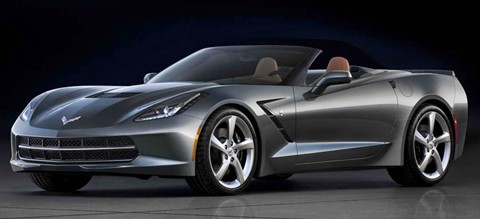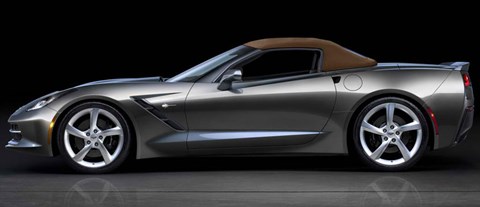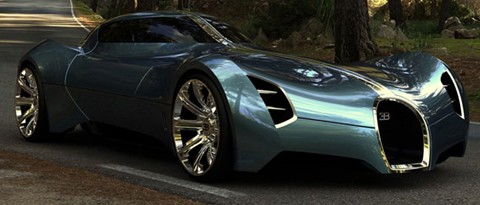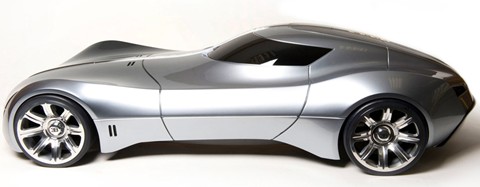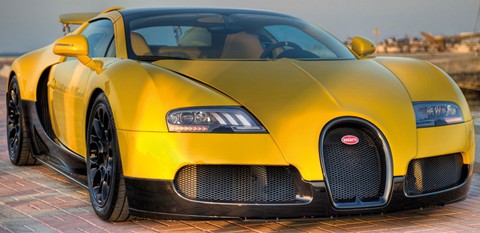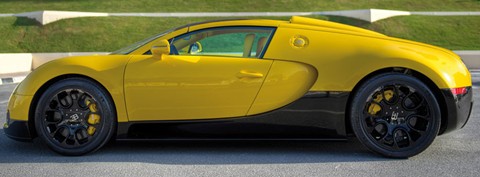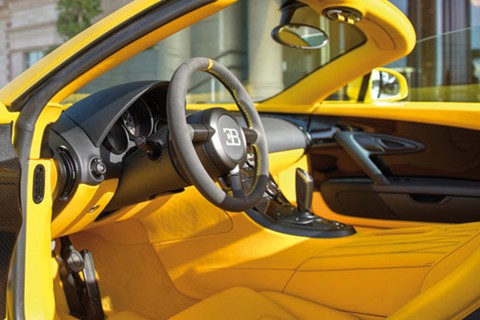As I’m driving through hairpin corners in the Dolomite Mountains of the South Tyrol region of Italy, the Ferrari FF’s two-door wagon body style is the last thing on my mind, which is interesting because it’s probably the first thing anyone else would notice about the latest four-seater from Maranello. Instead, my most pressing thought, besides not dropping a $300,000 GT car off a cliff, is the FF’s four-wheel-drive system, which has so tamed the 651-hp V-12 engine that a tail-out hero photo of a drifting FF requires serious commitment with the stability control fully switched off. When the back end finally does come around, though, it does so in a predictable, gentle manner. In sport mode, the sportiest of the five chassis settings accessible via the steering-wheel-mounted
manettino knob, the back of the car hardly wiggles on dry pavement.But the first roadgoing Ferrari to put power to all four wheels doesn’t understeer like so many other four-wheel-drive sports cars. It’s actually mostly neutral through corners. Ferrari engineers repeatedly explained to us that the front wheels are used mostly for traction in bad weather and that power is otherwise shunted to the rear wheels as much as possible. Based on a cockpit display of power to the front wheels (we were told the display won’t be on customer cars), however, that’s not entirely true, as the system activates on almost every uphill corner if you request full power. Without the display, the only clue the FF isn’t rear-wheel drive is the aforementioned lack of oversteer. There’s no torque steer, no power-on push. And so it seems that the biggest compliment we can pay to the FF’s groundbreaking four-wheel drive is, paradoxically, that it’s not really a big deal.
What is a big deal, of course, is the FF’s body, a shape known to most of the world as a three-door hatchback, or a shooting brake. The latter term dates to the days of horses and carriages. In more modern times, it represents a sporty car in which a gentleman has enough room to carry his guns and hunting dogs. But Ferrari doesn’t necessarily prescribe a tweed jacket and a couple of hounds for customers (of which there will be about 1000 per year worldwide); it sees the FF simply as an evolution of the GT car with more cargo space and more mobility than its predecessor, the
612 Scaglietti, had. Heck, this Ferrari even has cruise control and cup holders. How’s that for progress?
Evolutionary Styling…and Chrysler Nav?
The V-12 sits entirely behind the front axle, and it resides within a snout that brings to mind cars like the original
BMW M coupe or even the Jaguar E-type. Aside from the rear and its familiar round taillights, the Pininfarina-styled FF is an evolutionary step in styling away from Ferrari’s
California and
458 Italia, with headlights that stretch back along the front fenders and functional vents and ducts scattered about. Inside, the nozzle-shaped vents recall those of the 612 Scaglietti as well as the
599GTO. But living among the vents on the dash, we find the FF’s biggest disappointment: a stereo-and-navigation unit common to the entire Chrysler family. It’s not only disgracefully downmarket but also not very good. Primary map functions, such as zooming in and out, must be done with fussy touchscreen buttons. The steering wheel, like the one in the 458 Italia, houses the turn-signal and wiper controls, leaving the giant paddle shifters as the only protrusions from the steering column. The instrument cluster features a giant center-mounted tachometer flanked by two high-resolution LCDs. The right display shows speed as a digital readout or a conventional dial, and it displays the rear camera’s feed when reverse is engaged. The left display shows accessory dials, navigation and trip information, and any warning lights. Front-seat passengers can be entertained by an optional screen that shows engine and vehicle speed or trip information.
The rear seats are accessed by pulling up big aluminum handles on the side of each front seat to move them forward electronically. Ingress to the rear involves basically falling into the snug seat, although once you’re planted, there’s plenty of head- and legroom. Rear passengers sit slightly higher than those up front, stadium-style, and well-behaved sub-six-footers should last a few hours without complaint, or perhaps longer with the optional rear-seat entertainment system. Taller folk will fit, albeit less comfortably. The rear seats fold in a 60/40 split and feature a center-section pass-through. Seats up, the FF’s 16 cubic feet of storage beat the Porsche Panamera’s 15.7, but the FF loses to the Porsche with the seats folded, 28 cubes to 45.
In the late 1940s, Enzo Ferrari reluctantly agreed to build road cars as a way to finance his racing outfit.
One has to wonder, though, whether he would have signed his name to today's Ferrari FF, a four-seat, all-wheel-drive hatchback intended to broaden the brand and boost global sales. Designed to lure a new kind of customer, the FF comfortably totes four passengers and their luggage without worrying mortal drivers about landing wheels up in a ditch.

In 2012, sales in the U.S., Ferrari's largest market, were up 11.2% over 2011, according to research firm Autodata. Though Ferrari doesn't disclose sales for individual models, the company says the success of the FF helped global V-12 sales climb 22% in the first three quarters of 2012, boosting profit 7.6%.
A cursory glance at the spec sheet of our Ferrari FF tester tells you where at least a portion of that profit is derived.
The car starts at $295,000. But a liberal flogging of the options boxes ran our test car up to $377,341. That extra $82,000 includes an $11,000 "Grigio Abu Dhabi" paint job (or as it's known to us poor folk, silver). Other overpriced goodies include a $3,500 backup camera; a $5,800 suspension-lifting system to prevent driveway scrapes; and $4,400 privacy glass for the rear windows.
Curiously, a sport exhaust system costs just $700, a strikingly better value than the camera. Also odd for a car costing the GDP of New Hampshire: an outdated navigation and stereo system from a garden-variety Jeep.
But the important equipment on the FF — the drivetrain — comes standard. Mr. Ferrari would have no quibble here. A direct-injected 6.2-liter, V-12 engine makes 651 horsepower as it screams along at 8,000 revolutions per minute. The car makes 504 pound-feet of torque at a quieter 6,000 rpm. Ferrari says the bulk of that, 369 pound-feet, is available between 1,000 and 8,000 rpm.
A seven-speed, dual-clutch transmission routs power to the wheels, where Ferrari has installed a proprietary all-wheel-drive system that it says is 50% lighter than a conventional setup. The FF pulls off this sleight of hand by essentially acting as a rear-wheel-drive car most of the time. Only when the vehicle's systems detect the rear wheels slipping can up to 20% of the engine's torque be routed to the front wheels via a second, two-speed gearbox.
This system can also vary the torque sent to each of the front wheels. By pushing more power to the outside wheel when cornering, the FF can better pull itself through the turn.
The FF provides yet another layer of technology to keeping the car safely planted on the roadway, with a dial on the steering wheel that lets drivers choose among four electronically enhanced driving modes: snow, wet, comfort and sport. The various settings alter throttle response, transmission shift points, and traction and stability control thresholds. You can also shut the electronic nannies off entirely.

This being Los Angeles, 300 miles of testing were limited to dry roads, so the "snow" and "wet" settings went unused. A missed opportunity perhaps, but a testing environment that Ferrari says replicates where the vast majority of FF buyers will drive.
Also unused was the "off" setting. Neither I nor anyone who takes my phone calls has $377,341 to hand Ferrari after wrapping the car around one of Mulholland Highway's finest telephone poles. But "sport" mode allows more than enough fun, and the computers don't object to swinging the FF's tail around a bit when accelerating out of a turn.
Otherwise, the FF stays glued to the pavement and carves up curves with predictable precision. The chassis feels composed and solid, probably because of a hefty curb weight of 4,145 pounds, or about 550 more than Ferrari's latest V-12 GT car, the F12 Berlinetta. Only the overeager steering took careful attention.
Meanwhile, the dual-clutch transmission rips off rapid-fire shifts with ease. Even in full automatic mode, the gearbox has no fear of its 8,000-rpm redline and demonstrates remarkable intuition in deciding when and, crucially, when not to shift. The only minor weakness here was an occasional tendency toward abrupt downshifts at low speeds.
In daily driving, the FF proved remarkably easy to live with; this car shares little of the anxiety of its 458 Italia brethren. The ride of the FF's magnetic suspension, also seen on General Motors products including the Chevrolet Corvette, was perfectly compliant in both the normal and "bumpy road" settings














